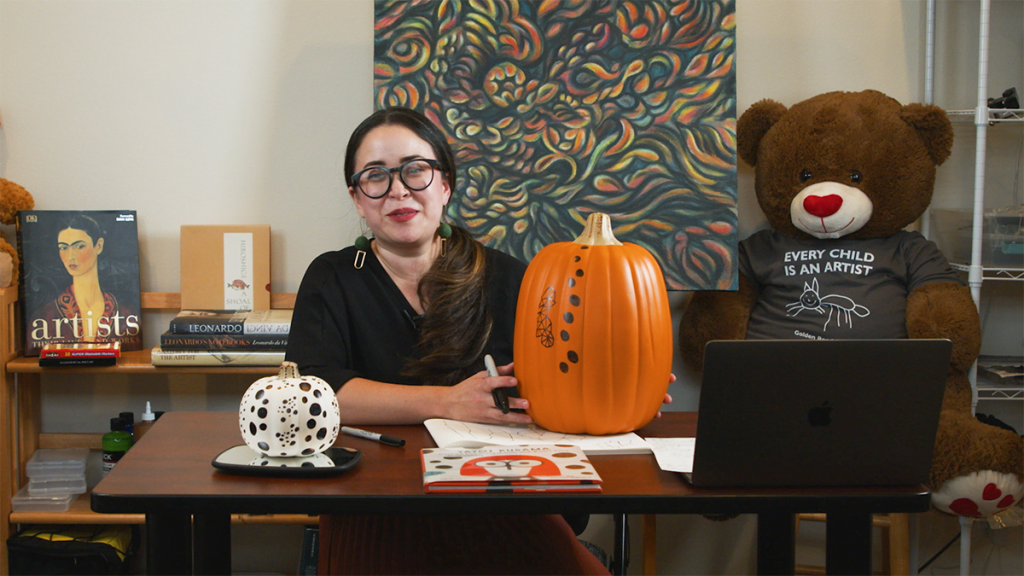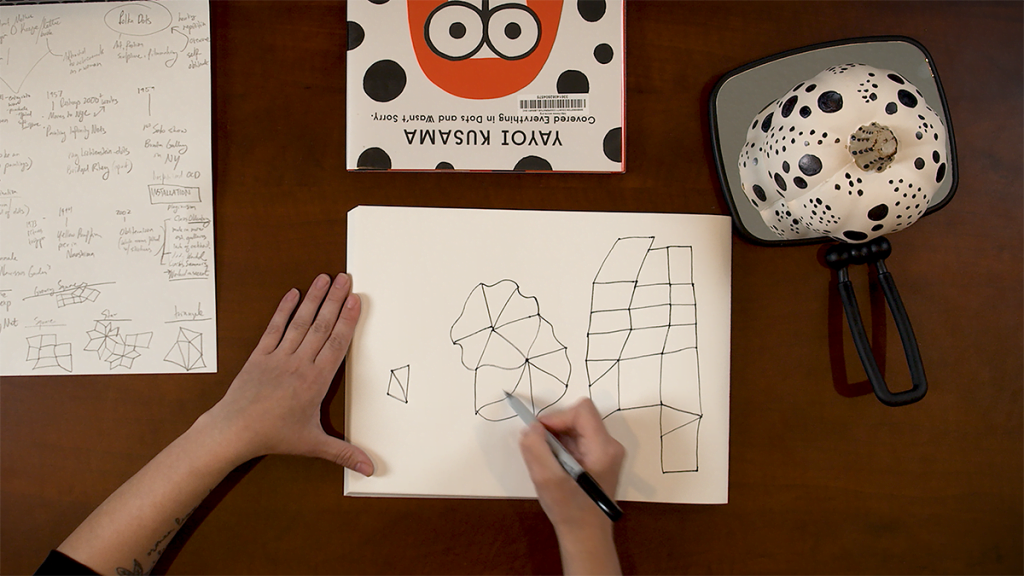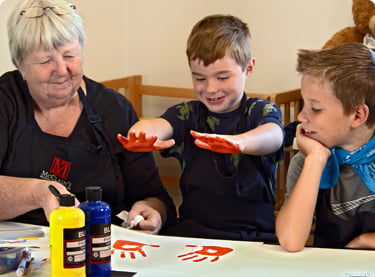Welcome back to another free art lesson from Golden Road Arts in Hillsboro. Last time we were here, we demonstrated how to make a Thanksgiving turkey centerpiece.
Today, Lindsey Holcomb is going to discuss the work of Japanese contemporary artist Yayoi Kusama and show how you can create art influenced by her unique style.
Create Japanese Contemporary Art Inspired by Yayoi Kusama
Discover how to create immersive shapes and patterns using polka dots and Yayoi Kusama’s Infinity Nets concept. Start with a pencil and paper, then advance to pumpkin designs.
Materials Required for Yayoi Kusama-Inspired Art
- Pencil
- Paper
- Marker
- Decorative Pumpkin
- PDF Lesson Plan
Scroll down to see images from the instructional lesson.
Get Creative With an Infinity Pumpkin Design
Follow the transcript below to find out how Lindsey takes some of the ideas and innovations of Yayoi Kusama and turns them into fun art projects for kids.
Hi, I’m Lindsay Holcomb with Golden Road Arts, and today we get to learn a little bit more about a fabulous contemporary artist from Japan named Yayoi Kusama. Now of course this is just a drawing of Yayoi but when you see pictures of her she’s instantly recognizable with bright red hair and she’s always wearing polka dots which we’ll talk a little bit more in-depth about today, about why polka dots were so important to her. She’s often referred to as the Princess of polka dots in fact.
So talking a little bit about Yayoi and her beginning, her early years of her life, she was born in Matsumoto Japan in 1929 and she was born to a family who was pretty well-to-do. They worked in seed collection and nurseries in a rural area of Japan and from a young child her parents did not encourage her to be an artist.
During that time in Japan girls were often expected to grow up and become wives and learn how to run a household and that was all that they were supposed to be interested in, so her parents actually made it very hard for her to learn art. There’s stories she’s told that they would rip up pictures that she had drawn and take away her art supplies, but she was a really creative child and she found whatever was around her that she could possibly use to make art with. Sometimes that would be mud, sometimes that would be using grains of rice. Sometimes that would just be using your standard writing pencil or pens that you would find in your house, nothing special in terms of art supplies. So her creativity couldn’t be stopped just by her parents not wanting her to be an artist.
Something also about Yayoi from a young age is she began to start seeing things that were not actually physically around her. Now you can call this hallucinations, but what it looked like to Yayoi is perhaps you’ve looked at a bright light at some point and if you’ve looked at that light and you look away you’re still seeing that light wherever your eyes are tracking. Sometimes that can happen if you’re looking at a really dark object. See these dots on this cover? If you stared at those for about 3 minutes or so, and then looked up to the wall you might see polka dots and this is what young Yayoi saw when she was about 10 years old. She described them as seeing fields of polka dots wherever she looked and when she saw this she kind of felt lost within these polka dots. Maybe like how we would feel if we’re looking at the night sky and seeing millions of stars, that’s what Yayoi felt when she was looking at her environment around her.
So in 1941, this was a very important year for Japan, Japan entered World War II with the United States, against the United States and it was a very tumultuous time to live in Japan. During that time especially as a young child, Yayoi had to contribute to the war effort by helping to sow fabric parachutes in a factory from the age of 12 and she would do this all day long sewing and sewing in a dark environment and it was a very difficult time for her. But as we’ll talk about a little bit later, she took this difficult time and translated it into her work when she was a more established artist.
During that time in Japan, she happened to be going into a bookstore one day and looking through some old books that were from the States and she happened to find an art book by a very famous artist, one of the most famous artists of the time from America, named Georgia O’Keeffe. Georgia O’Keeffe is very famous for painting bright vibrant flowers in a really creative impressionistic way which is very loose and dreamy and it left a huge impression on Yayoi and the type of art that she might want to pursue in the future when she studied art.
In Japan as a young adult, she was focused mostly on the Japanese style called nihonga which is a really controlled style of painting. There’s lots of rules, there’s only very particular ways that you can paint a plant or an animal or a landscape or a person and it takes years and years to master. That type of artwork affected Yayoi and seeing this new type of art, this is what we called abstract impressionism, was very inspiring and it kind of sparked something within her where she knew that she needed to go to the States to continue her art career.
So Yayoi was inspired by Georgia O’Keeffe’s work and she wrote her a letter and she explained in her letter that she was wanting to pursue art. She wanted to know how could she become an artist, how would that be possible for her in the United States, and in a huge act of generosity, Georgia O’Keeffe actually wrote her back and helped connect her with several of the people that she worked with in New York City. So following that Yayoi was able to move to the States and pursue her first solo exhibit as a professional artist.
So we’re going to talk a little bit about her work that she did in these early years in New York City where we start to see a lot of her polka dots that she’s so famous for. What Yayoi called her polka dots or her repeating patterns were infinity nets, infinity meaning going on forever and the nets she was describing that there was no focal point to her paintings, there was no one subject that you’re looking at, it’s all repeating patterns whether it’s dots, squares, triangles, different shapes, and she would create this way to kind of get lost and relax her mind. So if you’re drawing dots for 2-3 hours you’re going to be very relaxed, you’re gonna kind of lose your thoughts a little bit, and this is what Yayoi liked doing with her artwork.
So I wanted to show a little bit of examples of how she crafted her infinity nets and these are things that you can practice at home too and come up with your own patterns and your own techniques. I think with exploring you’re going to have a lot of fun. So if you can grab just a pencil, a pen and a sheet of paper we’re gonna walk through several different ways to work on an infinity net as Yayoi would and the first is going to be a square.
Now the nice thing about doing a square in the style of Yayoi Kusama is you don’t have to be precise, it doesn’t have to be a straight perfect line, you can see mine has a little bump up there, it’s crossing there I might say that’s not a very good square but it’s a great square because it’s going to do what we need for today. So let’s just draw another one next to it and as you could see we could keep doing this for a long time, some of them make lines just a little bit different. You can experiment with doing longer lines, short lines, slanted lines, and just always connecting them at the sides. This one, I might go down a little bit more, now you could continue this for a really long time in any direction and if you can imagine doing it in a very tiny way it would look really interesting if the entire page was covered in these squares.
So these are kind of what she would do in her studio relaxing all day in front of a big canvas and doing these tiny squares. I’m doing kind of bigger ones today but you can do any size that you want. Another thing that we can do with this square shape is what she calls the growing square infinity net and what that is is just like we’ve been making our squares here we’re going to add a triangle in every once in a while and by adding this triangle in it’s turning our shape even more in another direction. So I’m going to draw a square off of that side and like I said square I know we learn in school that they’re all the same side same length on each side but we’re just doing four sides in any length that we want.
For this activity, I’m gonna add another triangle here and you can just keep going and experimenting with your growing square infinity net. Ok, it doesn’t have to be perfect there is no wrong way to do it, just keep connecting those lines so like I said this is our square infinity net or a growing square infinity net with our triangles.
We can also do a curvy infinity net which she enjoyed doing and to start doing that we’re gonna just make kind of a squiggly triangle. I like to do kind of the squiggle on the top you do another next to it, doesn’t have to be perfect, just keep going around. It kind of looks like that parachute that you play with at a park or a class, or like the time the Yayoi was making them in a factory, so we have an entire shape now but we’re going to continue it in another direction, so let’s pick one of our wavy triangles and draw one off the side. Now this is my new center. OK, we can keep going like this for infinity really. Alright, see now we have two connected shapes and we could do another, so that is a wavy triangle infinity net or a curvy infinity net. There you can do it with straight triangles of varying shapes and it’s going to be much like this where we connected two different shapes, but focus a little bit more on straighter lines.
OK I’m gonna pick a corner of one of these to start my new shape and like the other shapes you can just continue doing this in any direction. Perhaps you could connect it with different shapes that you’ve learned here or with one of your own. You can make up your own design. I think the last one I’m going to show you with Yayoi’s infinity nets is a star shape, this one can be a little tricky to learn but it’s really fun to experiment with.
I started with drawing three straight lines there. I’m going to make a point kind of making each of these lines into a diamond. Some of them are going to be wider, some of them are going to be smaller, and that’s OK. OK so that’s kind of a star shape and now just like this triangle shape down here, I’m going to pick one of these points to start my new shape. It becomes a new star shape and you can keep doing this as long as you like, experiment with coloring them in in different ways, create repeating patterns, create different color combinations, you could do anything you want here there’s no right or wrong way to do it.
So if you can imagine Yayoi would make a painting that was just about the size of this big wall behind me and larger, so filling rooms almost with these repeating patterns and this is something she was really famous for during her work, her early work, in New York City in the late 1950s. Again we called these infinity nets, which she later moved into doing infinity rooms which is covering every single object in the room and the room itself in some sort of repeating pattern and she would often incorporate mirrors into her work to make it seem as if the shapes would continue forever. So you can see that, perhaps you can’t see that, we’ll play with it, have fun with mirrors and look at what kind of shapes you can get repeating and imagine what that would look like in such a large space over and over again.
Now Yayoi also considered herself a part of her art, and so when you see pictures of her you’ll often see her entire outfit her hair her accessories matching her infinity room that she’s created. That’s where the artist becomes part of the art and she’s very recognizable for that. So, moving a little bit later in her life she’s been doing these infinity rooms, infinity net artworks in New York City and she had a very hard time with lots of artists copying her ideas.
Now in art lots of us are taking inspiration from other artists and we say, I’ve been inspired by a type of artist or I’ve studied this certain type of artist and that’s OK. That’s how we all learn and everybody is inspired by somebody, but it’s always important to say I got this idea or I got this inspiration from a specific name, so and so, in this case Yayoi Kusama. Unfortunately during that time a lot of these people did not recognize her name or give her recognition for the type of work she was doing so she had a very hard time with working with other artists during this time of her life where she would put together a large show and work and then see something very similar by a friend even months later and probably getting a little bit more recognition or acclaim than her show did so that was a hard.
In her life where she decided to create a little bit more in secret, maybe you know this feeling where you don’t want to share your ideas that you’re really excited about with somebody in case they might copy it. That’s kind of what she was feeling like at that time and so in 19 about in 1960s she transitions a lot of her work to moving off of a page or a canvas and her infinity rooms to putting her patterns on people, on animals, on trees, on clothing, on everyday objects like bathtubs, really anything that she could put these patterns on she was putting patterns on. And so it kind of shows like her early years where she didn’t have a lot of things to create her artwork out of she just used her mind to use anything that was around her, she did that later in life as she was more of a professional artist as well.
So you might be wondering why I have this pumpkin here and Yayoi is very recognizable for her infinity pumpkins, where she does her repeating dots and patterns on a pumpkin. She’s written that she likes pumpkins because they’re simple, they’re sweet and they’re fairly unassuming and she kind of sees herself as a pumpkin. So we’ll see pumpkins in her work a lot and probably most famous is her yellow pumpkin that she did on a pier in Oshima, Japan in the 90s and we’ll show you a picture of that.
If you would like to try your own hand at making your own Yayoi Kusama pumpkin it’s very easy to do it. I know they’re not gonna turn out exactly like she would do it but they always look really fun no matter how you try so I invite you to now find either a real blank pumpkin. You could use a gourd, you could use a squash of any kind. And these are plastic pumpkins that I found at the store because it’s almost Halloween time, and all you really need is a permanent marker if you want to make it very easy you could use different colors or you could use acrylic paint and a brush, something some type of paint that won’t wash off easily. If we used watercolor or something like that, it’s going to run a lot so we want to use something that will really stick to these shapes of the pumpkin.
OK and so how we do these repeating shapes is you’ll notice that on the pumpkin it comes in these little sections, kind of gives us natural lines and sections on the pumpkin itself. And so you’re gonna use those as guidelines to start a new pattern. Over here I’ve done something simple where I’ve just done different larger dots intermixed with some smaller dots in different shapings. So you’ll see this took me about 10 minutes to do but we can work on one together on this bigger one back here. OK now if I were to cover this completely in dots that will take me quite awhile, but it would sure be a fun project so go ahead and do this. So Yayoi would pick one pattern to do in one specific section of the pumpkin or her pumpkin drying.
OK attached to this lesson you’ll find a print out where you can print out the sheet of paper of a pumpkin and practice your hand at doing different patterns and dots and have some fun with it, maybe before you use an actual pumpkin. You can do either way. Both are really fun so I’m just going to take a section and just begin because why not. Sometimes we don’t wanna think about it too much. I just know that I’m gonna work on this one section right here. I’ve made this side spot so I’m going to try to do that size spot again. Now I’ve chosen to do it a little bit in a random pattern either going that way. You don’t have to do that, you could do straight lines, you could do all the same size, you could do small dots and large dots mixed together. A lot of her dots are connected in her actual artwork which we’ll see so we’ll show some pictures of.
OK so if I were to continue with this, I’m gonna continue it all the way down this way. Now maybe we want to take something that we learned with her infinity nets and do a pattern on another section. So how about we try to do triangles, do the triangle infinity net. There’s my first triangle, and I just keep going around now every section could be the same or you can make them all different, you could take a pen after this and color in the different colors. Now in this case because the section is little, my shape isn’t going to be completely done and that’s okay, just gonna keep drawing connected triangles but, yeah, always infinity nets.
Can you imagine this is gonna look pretty neat when it’s completely done, it’s a very unique Halloween decoration if you wanted to do something creative for that. OK you’re just going to keep going on those triangles. I hope that by learning a little bit more about Yayoi Kusama today that you take away that you can create art with anything that is around you. You don’t need fancy materials, you don’t need fancy brushes or pens, just start making something. And in her case, polka dots brought her a lot of joy and relaxation. So what shapes bring you relaxation or what shapes do you draw that make it feel fun?
You might not feel the same way about polka dots but what could that be for you? When you’re doing your artwork that’s something fun to think about. I hope you enjoyed today’s lessons about Yayoi Kusama and you enjoy making your own pumpkin. Thank you so much for joining me today, again my name is Lindsey Holcomb. I’m with Golden Road Arts. Have a wonderful rest of your day.
Access Instructional Art Lessons From Golden Road Arts
At Golden Road Arts, we create engaging art content for elementary and middle school children. We also host live events in Oregon featuring fun and educational creative projects. To get started, watch our free art lessons now. You can also support the development of upcoming projects by donating to Golden Road Arts.
















